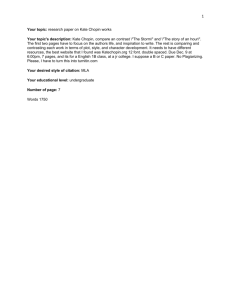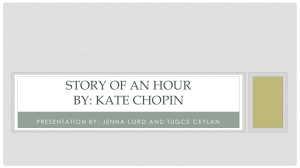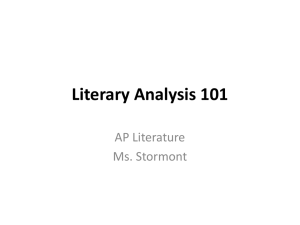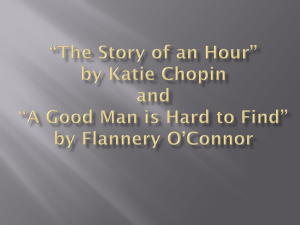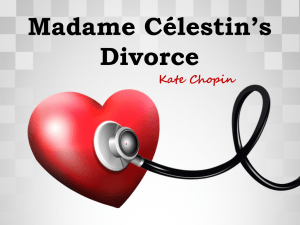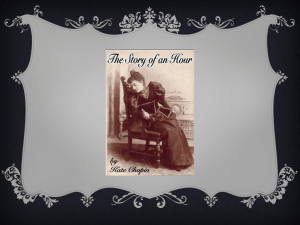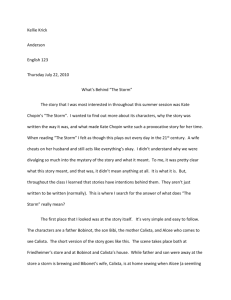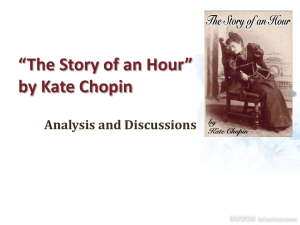Realism PPT Chopin Stories Updated
advertisement
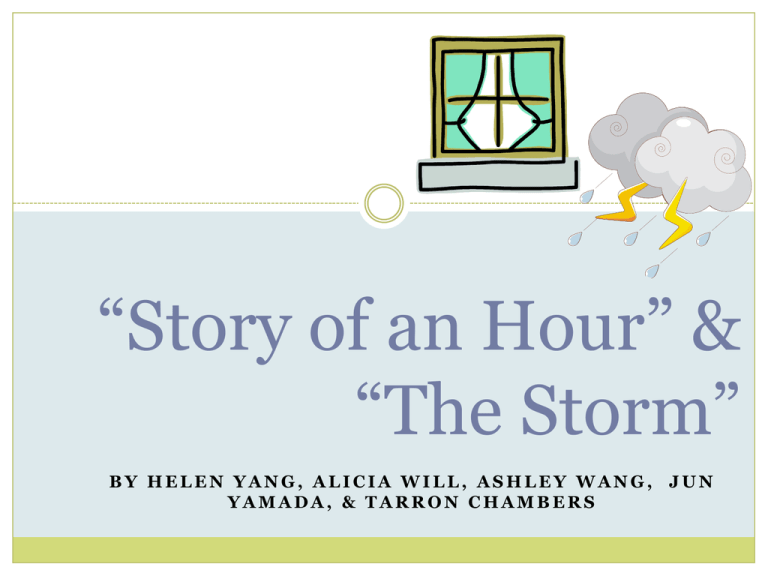
“Story of an Hour” & “The Storm” BY HELEN YANG, ALICIA WILL, ASHLEY WANG, JUN YAMADA, & TARRON CHAMBERS Connection to Realism Realism is defined as the “faithful representation of reality,” and it revolves around the social, economic, racial, and moral struggles of the middle class. From the time period of the 1860s to the 1890s, realism strays away from romanticism, idealism, or personal feelings and fixates on ordinary people and everyday life. Connection To Realism (pt. 2) “Story of an Hour”: The general plotline highlights the plight of women during the late 1800s and how women struggle with their freedom; it emphasizes the oppression that is placed upon women and its repercussions. Rather than romanticizing the plotline and relaying a dear story of a woman mourning over her husband’s tragic death, “Story of an Hour” pinpoints the liberation that came with the supposed death of her husband – a realistic scenario. Many of the women during the time period felt as if they were trapped and limited in what they were able to do; the death of her husband realistically represented a way for her to escape the trap, for there was no one to control her anymore. She believed that she was free to “drink … [the] elixir of life” and live free from the reign of her husband (Chopin 637). She was so oppressed that her husband’s death served as an opportunity to become liberated – a common feeling within women of the realism time period. Connection to Realism (pt. 3) “The Storm”: The general plotline of this short story focuses on the controversial nature of affairs within marriages; it tells the story of how two old lovers, both married to other people, rekindle their relationship with a stormy affair one night. Originally, the story was found to be immensely controversial – most likely in the light that it showed affairs as a positive thing, for the ending of the story showed that everyone was happy rather than chaotic in behavior. It gave the message that people who have affairs can get away clean and still remain in a strong marriage. Rather than the romanticized belief that those who commit to affairs will suffer consequences, in reality, oftentimes, people who are in affairs get away with it. Innocent people get hurt, and the “bad” people don’t get in trouble. As hard as it is to admit the fact that affairs are common, it is the realistic truth, and it happens increasingly whether one is wealthy or in a middle class family. Dramatic Irony: when the implications of a situation/action is understood by the audience but not by the characters “Story of an Hour”: “When the doctors came they said she had died of heart disease – of joy that kills” (Chopin 638). The doctors believe that Mrs. Mallard died because she was overly joyous due to her husband being alive, but the readers know that she was originally happy when she thought she was free. Her death was caused by shock/sadness/anger ; her husband’s life symbolized her further oppression. “The Storm”: “‘Oh, Bobinot! You back! My! But I was uneasy.’” (Chopin) Calixta expresses that she felt uneasy and worried about her husband and her son, yet it is evident that she was preoccupied with the affair rather than thinking about her family. Situational Irony: when the unexpected outcome occurs “The Story of an Hour”: “It was Brently Mallard who entered, a little travel-stained … He had been far from the scene of the accident, and did not know there had been one” (Chopin 638) Throughout the whole short story, it is implied and believed that Brently Mallard is deceased, and that his death is what causes Mrs. Mallard’s urge for liberation from the patriarchal stances of society. In the end, it turns out that Mr. Mallard is very much alive and wasn’t even aware of the accident – an unexpected plot twist. “The Storm”: “So the storm passed and every one was happy” (Chopin). Reader would typically assume there be some guilt felt by Calixta and Alcee or that someone found out of the adulterous affair, but nobody finds out. Everything works out despite popular expectations – Calixta and Alcee get away with their actions, and Bobinot and Clarisse don’t find out. Verbal Irony : speech in which the intended meaning of a statement differs from what is actually said “Story of an Hour”: “The Storm”: “When the doctors came they said she had died of heart disease – of joy that kills” (Chopin 638). “‘Oh, Bobinot! You back! My! But I was uneasy.’” (Chopin) The doctors believe that Mrs. Mallard died because she was overly joyous due to her husband being alive, but the readers know that she was originally happy when she thought she was free. Her death was caused by shock/sadness/anger ; her husband’s life symbolized her further oppression. *same as dramatic irony Calixta expresses that she felt uneasy and worried about her husband and her son, yet it is evident that she was preoccupied with the affair rather than thinking about her family. *same as the dramatic irony Story of an Hour: Symbolism How is the window a symbol of Mrs. Mallard’s deepest desires? How is the setting in general representative of the different spheres men and women occupied? The window directly represents the door to freedom. Mrs. Mallard's short-lived desire for freedom directly correlates to her window in respect that it represents freedom and a vision of independence from her patriarchal society. “No; she was drinking in a very elixir of life through that open window” (Chopin 637). Through this quote, Mrs. Mallard shows that she indulges herself within the beauty of the world; the natural scenery that can be seen outside the window represents both the spontaneity that is held in her future and the wonders of the world. Rather than being tied down to her room and home, the window serves as an opportunity to be free. The setting of the “The Story of an Hour”, depicts the social contrast that is present between the male and female populations within society. The setting represents the reality where women are tied to their homes and have no roles in society and minimal chances for freedom in the “outside” world. Story of an Hour: Marriage What view of marriage does the story present? In “The Story of an Hour,” it is shown that marriage is not necessarily done for love, but rather for convenience. This story takes place in approximately the 1800s when women were still under the dominance of men and had to marry to preserve their status in society. It can be assumed that this was a loveless marriage because when Mrs. Mallard learns of her husband’s death, she weeps tears of joy, instead of anguish. If she had truly loved him, then she would have been far more devastated than she was perceived. Lastly, it shows how the marriage was dominated completely by her husband. Her tears of joy and feeling of liberation prove that Mrs. Mallard was oppressed and confined to her husband’s ways. She didn’t have a voice in the marriage, which shows that the marriage of the time period wasn’t as equal as it is in modern days. Story of an Hour: Major Themes Connect the setting of the story to its major themes. How is Mrs. Mallard imprisoned? The setting of the story is very limited including only her bedroom and the stairs. This symbolizes the restrictions placed on Mrs. Mallard, not only in her own house, but also referring to her place in society. As a woman, Mrs. Mallard has very few freedoms and in this way she is “imprisoned” because she doesn’t have a say in matters that concern herself and instead has to conform to society’s way. Her tears of joy and overwhelming happiness show that she definitely felt trapped to begin with, and the window, being a symbol for her freedom, became all the more captivating. The Storm: Larger Message Why is “The Storm” such a controversial text? The primary reasons that “The Storm” is considered a controversial text is the sexuality of the text, the abrupt ending of the story and the message that the ending implies. In “The Storm”, Bobinot and his son Bibi are at a store, getting groceries among other things, while Calixta is at home sewing. A storm brews up and Calixta invites Alcee into her house so as to avoid being in the storm. Soon afterwards, they commit adultery in their own “storm” of emotions and feelings. The controversy lies in the fact that the affair is described first explicitly in the story and that the same affair is then ignored by the adulterers once Bobinot and Bibi return home, and that Calixta and Alcee remain free of any blame or trouble afterwards. Chopin even ends the story by saying “So the storm passed and everyone was happy,” which in and of itself seems controversial. However, Chopin’s short story shows the realistic nature of affairs in that they are not always obvious or easily discovered, and the committers of such an act are not necessarily punished. This also highlights Chopin’s belief that in the moment of passion of desire, the immediate effect is not a consequence, and may actually benefit those involved in the affair, as by the end “everyone was happy”. The Storm: Symbolism What are the two storms in the text? In “The Storm” , there are two storms that coincide with each other during the text: the literal thunderstorm occurring outside Calixta’s house preventing Bobinot and Bibi from leaving the store, and the metaphorical storm of lust, desire, and passion involving the affair of Calixta and Alcee inside Calixta’s home. As the thunderstorm picks up, it drives Alcee into Calixta’s home, causing the emotional encounter that follows, as Alcee and Calixta remember a past time when Calixta was younger. As the physical storm of nature stirs up, so does the emotional storm that Alcee and Calixta both experience. As one storm subsides, so does the other, and the storms become no more than a relic of the past. Bobinot and Bibi can finally return home, and Clarisse, Alcee’s wife, is also oblivious to what has occurred, all three remaining in ignorant bliss. The suddenness of these storms shows the quickness with which emotions of desire and passion can present themselves, as well as how fleeting these feelings can be, ultimately demonstrating Chopin’s use of symbolism in the form of the storms to represent the realistic nature of affairs, in that they can be passionate, yet fleeting, while subsiding without any incident while also using a writing style somewhat explicit in nature, atypical of the time period. The Storm: Bobinot and Bibi Why is it significant that Chopin includes Bobinot and Bibi in the story? What is the significance of their sympathetic characteristics? Bobinot and Bibi represent the ignorant and innocent portion of the society. Despite the fact that Bobinot and Bibi are “betrayed” by Calixta when she chooses to have an affair with Alcee, Bobinot and Bibi remain “clueless” and unaware of this, and treat everything as if nothing had ever happened. This cluelessness represents the theme that “ignorance is bliss”, where it refers to Bobinot and Bibi, for being unaware about Calixta’s affair, yet, ironically being happy and sympathetic for Calixta instead. Their excessive sympathetic tendencies reveal their innocence throughout the situation, thus further exemplifying the controversial nature of affairs. Various people throughout society take part in adulterous natures, and there are innumerous people who are oblivious to the actions, such as Bobinot and Bibi. Their sympathetic characteristics show that despite their good intentions, they still get hurt, even though they are unaware of it at the time. Realistically, nice people get hurt – not just bad guys. Internal Conflict “The Storm” “The Story of an Hour” There is a lack of internal The internal conflict became conflict from Calixta as she undergoes the affair with Alcee. Rather than contemplating whether to go through with her decision or thinking about whether or not to tell her family about her actions, she blissfully has an affair. Throughout the whole story, there is no guilt shown from her either. amplified as she showed how free she felt once she realized her husband was allegedly dead. She was struggling with having her own voice and not confining to the limitations of society. She subconsciously felt trapped and oppressed – trapped in her home mentally. External Conflict “The Storm” “The Story of an Hour” External conflict is shown Mrs. Mallard is confined to her through the actual storm outside (man vs. nature) because it poses as an obstacle for Bobinot and Bibi to come home to Calixta. In addition, there is a conflict as having an affair is conflicting toward her husband, as it’s a struggle between the marriage they share together. home; she’s trapped by her room and her home, and she was plagued with having to remain in the home, for as a women during the times, she was meant to do domestic chores. Simile “The Storm” “The Story of an Hour” “… beating like a “She carried herself hammer…” “… was like a creamy lily…” “… was like a white flame…” “… as white as the couch as she lay on…” unwittingly like a goddess of Victory” Personification “The Storm” “The Story of an Hour” “her passion … which “physical exhaustion penetrated and found response in depths of his own sensuous nature…” that haunted her body”
